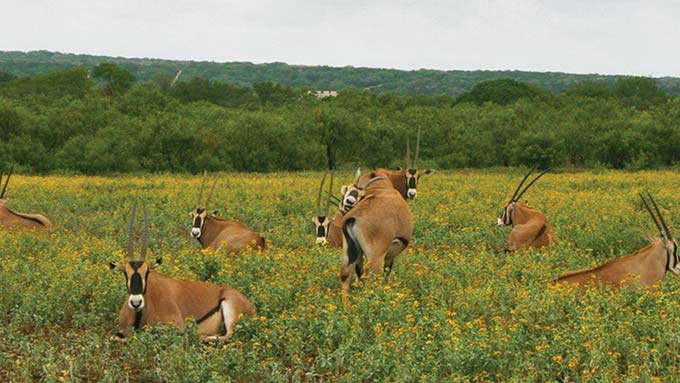If you want . . . HISTORY
Waggoner Ranch
510,525± acres | $725 million
When Dan Waggoner got his start ranching, in 1849, California wasn’t a state, Germany wasn’t a country, and Honest Abe was still just a freshman congressman. A couple of years after buying his first herd of Longhorns, Waggoner set out from East Texas and landed in the heart of Red River country, where he and his son, Tom, created a cattle kingdom that now spans six counties. The Waggoner is bigger than Bahrain and, in case you’re counting, sixty other countries. It includes some eight thousand head of cattle and more than a thousand oil wells and is the largest contiguously fenced property in the U.S.
More than that, it reeks of history. Thanks to the wealth and power afforded to them by the ranch, Waggoner and his descendants left significant imprints on American culture. Quanah Parker, as the leader of the Comanche, was a close friend and key business associate of Dan and Tom’s. Teddy Roosevelt, as the leader of the United States, joined the Waggoners on a turn-of-the-century wolf-hunting expedition. One of the country’s greatest quarter horses, Poco Bueno, was a Waggoner stallion. And both the Buick Electra and the Lockheed Electra were named for Dan’s great-granddaughter Electra Waggoner Biggs. Even the current heirs set a historic milestone when they decided to sell the property this past August: the price tag is the highest for any real estate listing in the nation.

Gemsbock at the Y.O.
If you want . . . HUNTING
Y.O. Ranch
27,500± acres | $75 million
A century ago, hunting in Texas was a homegrown affair. Native species—white-tailed and mule deer, wild turkey, bobwhite quail—were the only game around. Then, in the twenties, unregulated hunting practices began to seriously deplete the state’s wildlife, and Caesar Kleberg, a longtime foreman on the King Ranch’s Norias division, decided to do something about it. A pioneering conservationist, he spearheaded efforts to restore native populations (with strict hunting rules, brush shelters, and predator control) and went a step further: believing that nonnative species might also thrive in the Lone Star State, he introduced the nilgai, an antelope from South Asia. The result was, so to speak, a game changer.
Today, hunting is a billion-dollar industry in Texas, and no ranch enjoys greater renown for its exotics than the Y.O., a.k.a. “America’s Original Game Ranch.” Established by Captain Charles Schreiner, the Y.O. became the first Texas ranch to lease land for hunting under his son’s widow, Myrtle; in the fifties, his grandson Charlie Schreiner III introduced the first of more than sixty species of exotics that now roam the family’s Hill Country refuge. Want to bag a Père David’s deer? That will set you back $5,500. A gemsbok? $7,500. The price on a kudu is $18,000, and that’s not including guide fees. But, hey, at least you won’t have to make the trek to Africa.
If you want . . . SCENERY
French Ingram Ranch
14,035± acres | $11.2 million
As you probably already know, an ongoing drought plagues the rivers and reservoirs all across Texas, especially the Pecos River. But here’s what you probably don’t know: the Pecos is really only affected north of Independence Creek. Follow the river south, until it runs together with the Independence in West Texas’s Terrell County, and something magical occurs. Birds appear. So do canoes, kayaks, fishing poles, and bathing suits.
It’s along this stretch of the Pecos—a green-blue ribbon of seven miles—that the French Ingram sits. The ranch presides over an abundance of crystal-clear water that seems absurd in the heart of the desert or, for that matter, anywhere in Texas. (Try buying a single mile of river frontage along, say, the Guadalupe or the Brazos.) But that’s not all. The ranch—which has been owned by the Ingram family since the twenties, when husband and wife French and Merle Ingram bought this tract—includes majestic live oaks, a view of the Sierra Madre Oriental, an Old West cattle trail, and troves of Native American pictographs etched into the limestone riverbanks. Don’t think of the French Ingram as a ranch. Think of it as an oasis, a Garden of Eden where the Edwards Plateau meets the Chihuahuan Desert.








